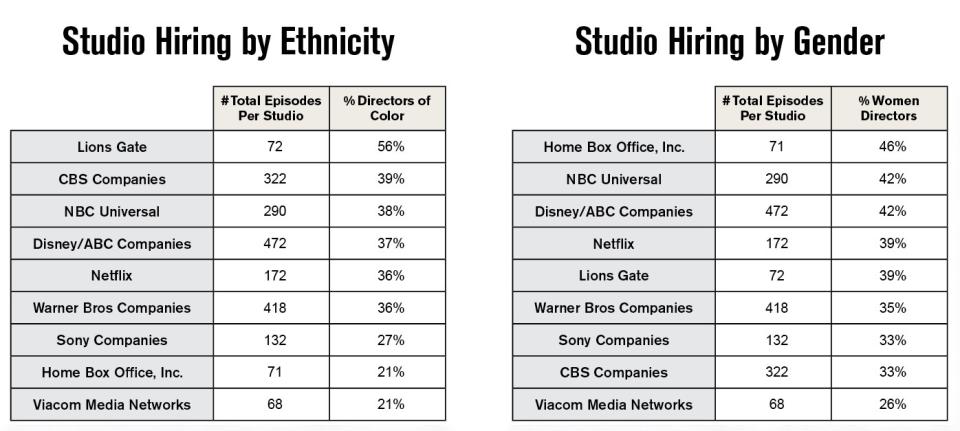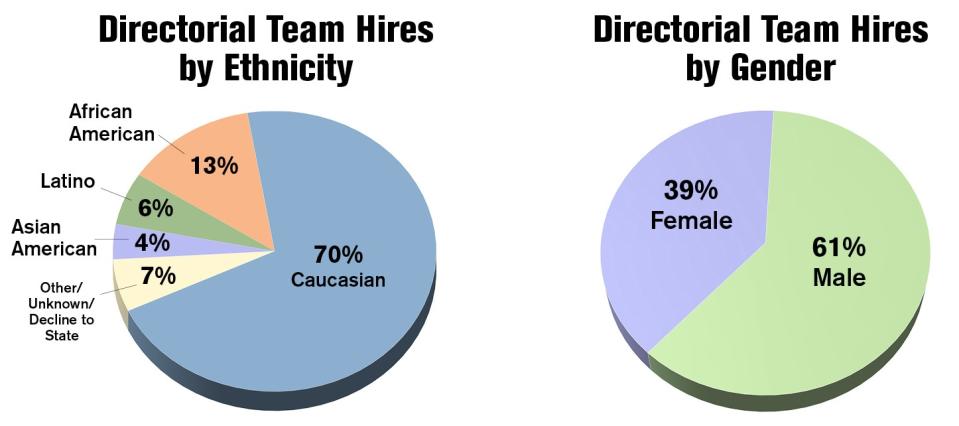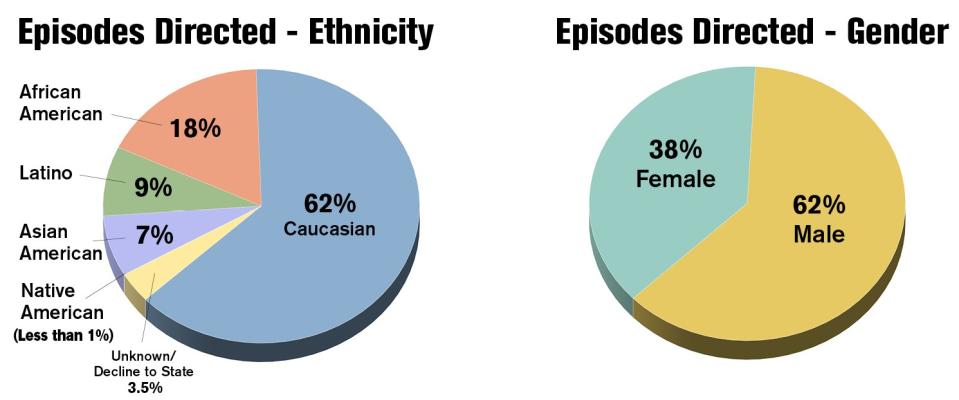Record-High Percentage Of Women & People Of Color Directed Episodic TV Shows In Covid-Hit 2020-21 Season, DGA Reports

Despite a precipitous 36% decline in the number of scripted television episodes produced during the worst days of the Covid pandemic, the percentage of women and people of color who directed them reached record highs in the 2020-21 season.
According to the latest DGA Inclusion Report, 38% of the episodes in the 2020-21 season were directed by women, which was up 8.6% from 35% the season before, and more than double the 16% they directed in 2014. People of color directed 34% of the episodes, which was up 17.2% from 29% in the prior season, and more than double their 16% from 2014.
More from Deadline
Even so, the guild noted that “While the shares of episodes directed by women and directors of color continued to see incremental growth, gains were not evenly shared. Latino and Asian directors saw minimal gains, continuing to remain underrepresented at 9% and 7% respectively.”
Despite these percentage gains for women and people of color, the actual number of episodes they directed declined dramatically during the pandemic-shortened 2020-21 season because there were far fewer episodes for them to direct than in the prior year. According to the report, there were 2,691 DGA-covered episodes in the 2020-21 season, which was down by 1,495 episodes from 4,186 episodes in the prior season. That resulted in about 440 fewer episodes for women to direct, and nearly 300 fewer episodes for people of color to direct.

DGA
“When the pandemic hit, a big question on our minds was whether progress on inclusive hiring would backslide as the production environment changed radically with the implementation of necessary Covid Safety Protocols,” said DGA president Lesli Linka Glatter. “Despite all the production challenges, the good news is that inclusive hiring continued its upward climb last year – both in overall hiring, as well as hiring of first-time directors. That said – although there has been continued progress, the goal of a level playing field for all has not yet been achieved. In addition, the statistics clearly reveal this, especially for our Latino and Asian members.”
The report found that 18% of episodes in the 2020-21 season were directed by African Americans, which was up from 15% in the prior season. This year’s inclusion report, however, does not include the prodigious output of director Tyler Perry, who is not mentioned by name in the report. A footnote states that “In designing the parameters for this year’s report, the DGA made a change to its methodology and data collection to improve the overall accuracy of the report. A decision was made to remove one outlier from this year’s report. An African American director with up to 150 episodes annually inaccurately overstates the employment of African American directors. All data in the report comparing 2020-21 to previous years has been adjusted so that statistics are comparable.”
According to the report, 9% of episodes were directed by Latinos in the 2020-21 season, which was up from 7% the year before; 7% of episodes were directed by Asian Americans, which was about the same as the prior season, and less than 1% of episodes were directed by Native Americans, which was also similar to the previous season.
Broken down by gender, Caucasian men directed 39% of the episodes and Caucasian women directed 23%; African American males directed 11% of the episodes and African American Females directed 7%; Latino males directed 5% and Latinas 4%; Asian American men directed 5% and Asian American 2%; Native American men directed 0.3% and Native American women 0.1%.
Looking at the data a different way – counting the number of individual directors whether they worked on a single episode or on many episodes in the season – the DGA found that there were 896 individual directors hired to work in the 2020-21 season on 170 DGA-covered U.S.-based scripted TV series. Of those directors, 39% were women; 61% were men; 64% were Caucasian; 15% were African American, 8% were Asian American, 9% were Latino, .02% were Native American, and 4% were unknown/declined to state their race or ethnicity. By contrast, in the prior 2019-20 season, when 1,268 individual directors were hired, 35% were women and 11% were African American.
According to the DGA, the major studios oversaw the production of nearly three-quarters of the episodes covered in its latest report. As these charts show, of companies that oversaw the production of at least 50 DGA-covered episodes, Lionsgate had by far the highest percentage of directors of color (56%), while Viacom Media Networks was tied with HBO for the lowest percentage (21%). HBO, however, had the highest percentage of female directors (46%), and Viacom Media Networks again had the lowest (26%).

DGA
A footnote says that the report “tracks employment by television studios (production), as opposed to distribution platforms. Many studios also produce series for third parties, and some studios are not affiliated with a distribution platform.”
The DGA, for the first time, also released data about the inclusion status of director teams working alongside directors on scripted episodic shows. “For the purposes of analysis,” the report says, “a single job was defined as follows: a crew hire in a work
category of unit production manager, first assistant director, second assistant director, second 2AD, additional 2AD, and DGA-covered location managers.” The DGA notes that this data is based on full-season hires and not on individuals hired for just a day or for a few days on an individual episode.
The report shows that there were 1,180 total directorial team jobs for the 2020-21 season made up of 1,011 individuals, with some individuals working on more than one show during a season.
Broken down by gender and ethnicity, 465 of the directorial team jobs went to women, making up 39% of the total, while 280 directorial team jobs went to directorial team members of color, making up 24% of the total. African Americans represented 13% of the jobs, Latinos 6%, Asian Americans 4% and Native Americans 0.6%.
A breakdown of the individual directorial team job categories by gender and ethnicity shows the following:
• UPMs: 201 total jobs – 33% female; 11% people of color
• 1st ADs: 338 total jobs – 31% female; 22% people of color
• 2nd ADs: 641 total jobs – 46% female; 29% people of color

DGA
“We are proud to be issuing our first-ever inclusion report of the directorial teams in episodic television,” Glatter said. “By focusing on full-season hires – we have been able to create an important new baseline of current studio hiring practices for the directorial team. Unfortunately, this report reveals that the studio hiring practices for the directorial team raises areas of concern, particularly regarding the hiring of ADs and UPMs of color who represent less than one-fourth of all team members hired last season.”
The guild also noted that it has begun the process of identifying and tracking data on LGBTQ+ members and members with disabilities in 2021 and will be looking to add inclusion statistics regarding those members in future reports.
The report, as have past reports, also looked at the hiring data for first-time episodic directors. Over the years, the guild has complained that too many of these “first-break” episodic directing gigs were being given to show insiders who often don’t pursue directing careers, and that they tend to be much less inclusive.
“Recognizing that inclusion cannot truly be achieved until the pipeline changes,” the DGA says that it has been “closely monitoring for many years the numbers of first-break jobs given to those affiliated with the series in another capacity, predominantly writer/producers and actors vs. those given to individuals who were hired for their experience as directors working in other genres such as features and commercials,” which the guild calls “career-track directors.”
In the pandemic-affected 2020-21 season, employers hired 113 directors who had never directed episodic television before. Overall, the percentage of first-break jobs going to directors of color grew to 39% (up from 29% in the prior season), while the portion going to women was 46%, down from the prior season’s 48%.

DGA
Of those first break jobs, 72 (64%) went to directors affiliated with the show and 41 (36%) were given to career-track directors. According to the guild, “The pools of career-track directors and affiliated hires differ in terms of diversity – with the pool of career-track directors having higher percentages of people of color and women than affiliated hires. Women represent 55% of career-track director hires vs. 40% of affiliated directors. Forty-four percent of directors of color are career-track directors while 38% are affiliated with the show. These inclusion differences are important because as DGA data complied since 2009 shows, two-thirds of career-track directors continue on to direct on another series, where only 25% of affiliated directors went on to direct for a series with which they had no affiliation.”
In conclusion, the DGA noted that it “has been pressing studios, networks, and producers to be more inclusive in hiring for nearly four decades. The Guild’s efforts include: collective bargaining gains requiring television studios to operate TV director diversity programs; ongoing meetings with studios, networks and individual series regarding their hiring records; and publicized reports detailing employer hiring patterns. In addition, the Guild itself has initiated a variety of TV director mentorship and educational programs to support the career development of its members.”
Best of Deadline
2022 Awards Season Calendar - Dates For The Emmys, Tonys & More
Awards Season Red Carpet Photos: Grammys, Oscars, SAG Awards & More
Spring Premiere Dates For New & Returning Series On Broadcast, Cable & Streaming
Sign up for Deadline's Newsletter. For the latest news, follow us on Facebook, Twitter, and Instagram.

